Friday, November 15, 2013
Samsung reportedly working on Galaxy phone with wraparound display
Apple releases iOS 7.0.4 Possible jailbreak?
Tuesday, November 12, 2013
Apple's iPad Mini with Retina Display Available Today
The 2048 x 1536 resolution screen is much crisper, making photos, videos and text appear sharper. The tablet starts now at $399, rather than the $329 the original Mini cost. However, Apple is still keeping that original, lower-resolution Mini on shelves for $299.
Of course, the two smaller tablet siblings are also joined by the iPad Air, which has a larger 9.7-inch display and a higher $499 starting price. The Air and the new iPad Mini with Retina really only differ in size. They both have Apple's new A7 processor, a similar design and Retina Displays. Apple will also still offer the iPad 2 for $399.
Though the new iPad mini goes on sale today, brick and mortar Apple stores won't sell it to walk-in customers directly. Instead, customers will need to place an order online and request in-store pickup, instead of just buying one on the spot at an Apple store. However, the new iPads will also be sold through AT&T, Sprint, T-Mobile, Verizon Wireless and select Apple Authorized Resellers.
And analysts and reviewers tend to believe the same, that Apple continues to have the lead in the competitive market. While the other companies have come up with clever new hardware and software features, Apple's new thinner and lighter tablets and the availability of over 475,000 apps continues to put the tablet pioneer in the lead, even if the prices are higher.
"At $399, the new iPad Mini is certainly one of the more expensive 8-inch tablets on the market and a few multiples of the price beyond the least expensive Android tablets," Ross Rubin, principal analyst for Reticle Research, told ABC News. "However, it includes premium components including the high-resolution display and high-end A7 processor."
Monday, October 14, 2013
New iOS 7 tips and tricks
At long last, iOS 7 has arrived. That is, it arrived for everyone who didn’t say “Developer? Oh, yeah, I’m totally a developer. Cough” and wiggle into the Beta months ago.
iOS 7 is a strange new land, especially on day one. Out with the gradients, in with the trippy fluorescents. Your favorite app? It probably looks completely different now.
It can be confusing, but we’re here to help. iOS 7 has all sorts of nifty little tricks tucked away in places that are in no way immediately obvious, especially if you haven’t followed Tim Cook’s every word along the way.
If you’ve been using iOS 7 for a while, you might know some of these. Hell, you might know most of these. But we tried to cover the bases to make sure that most people learn a thing or two. (Know all of these? You’re way cool, high five. Share another trick down in the comments!)
Swipe Down For Search:
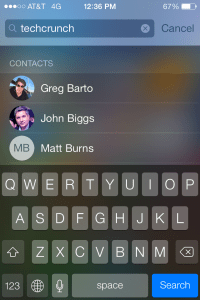
Gone are the days of having to swipe or tap your way to iOS’ dedicated search page. You can now access Spotlight search from anywhere on the homescreen. Just swipe down in the middle of the screen.
You can use Spotlight to quickly search across your device’s apps, emails, and contacts — but curiously, it seems that Apple has removed Spotlight’s ability to search the web. I’m pretty sure I never actually used that, but this is the Internet so I’m supposed to complain now that it’s gone.
Swipe Up For Toggles:
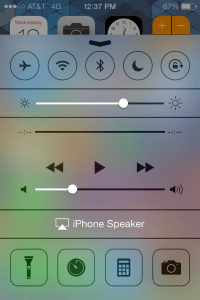
Toggles! At last!
Fixing what is perhaps one of iOS’ most glaring, long-lasting omissions, iOS 7 puts one-click access to things like Airplane mode and Wi-Fi/Bluetooth toggles just one swipe away, instead of hiding them in settings.
To get to the new Control Panel, just swipe up from the bottom of the screen anywhere you might be. You’ll get buttons for Airplane mode, Wi-Fi, Bluetooth, Do Not Disturb, Orientation lock, and sliders for brightness and media control. Oh, and there’s a flashlight in there. So if you were thinking about building a dedicated flashlight app, now is probably not a good time.
(Pro tip: The control panel is available from the lockscreen. Also: if the control panel is sliding out and interrupting your Candy Crushin’ time, you can block it from sliding out while in an app in your settings.)
Reveal iMessage and SMS Timestamps:

iOS has always been kind of weird about telling you when a message was sent or received. It’ll tell you when some messages came through — but only if it’s the first one that’s come through in a while in a given thread. If you sent a bunch of messages around 12:45, for example, you’d normally only get that first 12:45 timestamp.
With iOS 7, you can reveal the timestamp for each and every message. Just grab one of the speech bubbles in a thread and swipe to the left. Tada! Timestamps! Never argue about exactlywhen a message was sent again! (Because, yeah, I’ve had those arguments. Seriously. Sigh.)
Built-In Level:
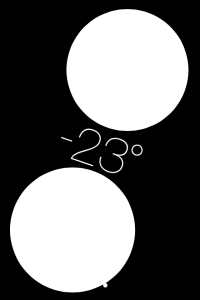
Building a house boat? Hanging a picture? Just want to show off one of the stranger new tricks that your iPhone has picked up?
iOS 7 has a built-in bubble level, of all things. I thought it was a pretty strange addition at first… but then I found myself using it one day. Then again the next.
To get to the level, open the compass app. Though not immediately obvious, there’s a second page to the app; swipe to the left, and you’ll be at Apple’s level.
(Pro tip: Double-tapping the screen resets the level to consider whatever angle the phone is currently at to be 0°. That design choice, expressed through a series of colored flashes, isn’t super intuitive.)
Swipe To Close Safari Tabs:
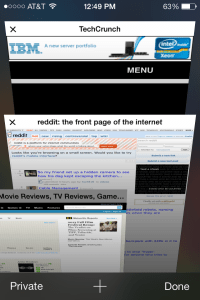
Safari has a new, scrolling 3D tab interface that allows for just about as many tabs as you want.
Alas, these tabs also have new, tiny “X” buttons that make closing them quickly a bit of a pain.
Forget the X button — it’s for chumps. Swipe the tabs away to the left, instead. It’s a whole lot faster, and requires less precision when you’re trying to dump a bunch of tabs on the go.
Call/SMS/Facetime Blocking:
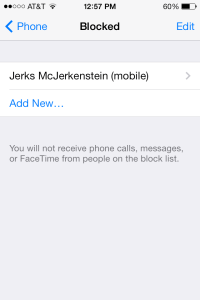
“Surely, there’s got to be a way to block phone numbers,” said every iPhone user ever.
Really, just type “How to b” into Google and let it autocomplete. First result? “How to block a number.” Second result? “How to block a number on iPhone.” Third result? “How to be happy.” This feature is in greater demand than happiness! Happiness!
Yet, until now, there hasn’t really been an easy way.
With iOS 7, it’s finally a pretty straightforward process to block people from calling, messaging, or FaceTime-ing (FaceTiming? Facing? Agh.) you. You can find the block list at either Settings > Phone > Blocked; Settings > Messages > Blocked; or Settings > FaceTime > Blocked. Note, however, that the block list is universal — block them in the phone settings, and they’re blocked on FaceTime, too.
App-By-App Cell Data Usage/Blockage:
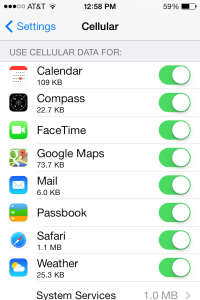
Want to see which app is using up all of your cell plan’s precious megabytes? Want to keep Pandora from streaming unless it’s on Wi-Fi?
Pop into Settings > Cellular and scroll down to the bottom. You can see which apps have used the most cell data and block any app from using cell data at all. (Note: An app needs to have used cell data at least once for it to show up in the list.)
How To Close Apps:
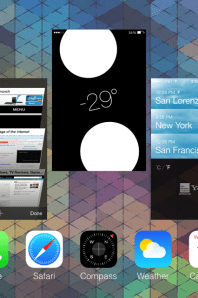
We’ve had a bunch of requests for this one since this post first went up, so here you go.
Apple changed the App Switching/App Closing mechanism up a bit with iOS 7. It used to be that to close an app, you’d double tap the home button, wait for the app drawer to slide out, then press and hold on an icon until the little “X” appeared.
With iOS 7, the whole thing looks and works a bit more like webOS of yesteryear. Double tap the home button to bring up the fullscreen app switcher, which provides a screenshot of each running application in a sideways-scrolling carousel. To close an application, simply swipe the app’s screenshot up and off the screen.
(Note: You really shouldn’t need to close apps all that often. Unless the app has crashed and refuses to fix itself or it’s doing something that is eating your battery, iOS 7 is designed so that most apps use little to no resources when in the background.)
Bonus Tricks:
- Folders can now be paged, allowing them to hold a huge number of apps.
- Safari still has private-browsing mode, it’s just in the app itself now instead of hidden away in settings. Find the switch in Safari’s tabs screen.
- Airdrop, Apple’s much touted system for wirelessly transferring files to other nearby iPhones, only works with the iPhone 5 and later. (I’ve spotted many a 4S user wasting time trying to figure out how the heck to turn it on, when the option simply isn’t there for them. Don’t worry, I wasted a good 10 minutes myself.)
- Miss the “List” view in the calendar app? It’s still there, just not immediately obvious. Tap the search icon to bring up a scrollable list.
- If you’re into using default ringtones, give Apple’s list another look. They’ve added a bunch of new trancy ringtones and chiptuney text alerts.
- Siri has picked up a bunch of new tricks. You can toggle settings (“Turn On Do Not Disturb”), ask for recent tweets (“What is TechCrunch saying?”), show you pictures (“Show me pictures of cats”) pulled from Bing, provide Wikipedia info inline (“Tell me about TechCrunch”), post to Facebook, play back voicemail, list recently missed calls, and find restaurants on Yelp and make OpenTable reservations.
- iOS 7 keeps tabs on where you hang out most, allowing it to cache relevant nearby data. It’s neat, if a bit spooky. Once you’ve used iOS 7 for a while, go to Settings > Privacy > Location Services > System Services to view a list of your frequent haunts. You can also turn this feature off at the same location.
Sunday, October 13, 2013
Apple's Best Fortune Tellers See Bigger iPhones (And Much More) For 2014
Many are quick to dismiss the rumor mill — and with good reason. Anyone with a website and an idea can post, “Apple to release really cool gadget next year with features I want.” But some sources are better than others. David Hsieh of DisplaySearch is on such source and KGI Securities anaylst Ming-Chi Kuo is another. One of their secrets is that Apple can’t introduce a product at all without acquiring literally millions of parts and getting them into their supply chain to make their product launches possible. I’ve discussed this before, but it’s worth reiterating: Just because the Nexus 7 has a Retina-quality display (and it’s a nice one, I can say from experience) doesn’t mean the iPad Mini could have had one 6 months ago. For all Google/Asus’ success with their tablet, Apple sells millions more.
To do a Retina Mini, Apple needs to have acquired 10 million screens before shipping a single unit and to be certain that it could obtain 10 million more each subsequent quarter. The way it does that is through a series of supplier agreements with display makers that are negotiated far in advance and often lead to dedicated production of Apple specified screens for its products. Hsieh, who has been in the business for a long time, talks to everyone, tries to figure out who is making what for Apple, and then attempts to discern how it relates to future products. From that, he’s produced a “best guess” a the 2014 product line.
There's a new way that advertisers could track you around the web, andyou might be surprised about where the tracking data would come from:your device's accelerometer. According to SFGate, security researcherHristo Bojinov has discovered a way to distinguish individual devicessimply by looking at data their accelerometers provide to webpages.Because accelerometers work imperfectly, they all display a uniqueresult when idle — that result, Bojinov says, is enough to track adevice around the web. THIS IS FAR FROM THE ONLY TRACKING TOOLADVERTISERS HAVE A website would just need to implement a small pieceof code in order to begin tracking a device this way, reports SFGate.Though Bojinov can't say for certain whether anyone is already doingthis, he says he'd be surprised if an advertiser wasn't alreadyexploring the possibility. To see how effective the method is, you canview your own mobile device's accelerometer footprint at a website setup by Stanford, where Bojinov is a PhD candidate in computer science.While you'll have to actively flip the phone around in order to make itwork, that reportedly wouldn't be necessary for actual tracking.Bojinov's research should be published in the coming months, SFGatereports. But while he may describe a surprising and eerie way to trackdevices, it's far from the only tool advertisers have for tracking:even outside of cookies, advertisers can distinguish between differentpeople just by looking at information their browsers always hand over,like what fonts they have access to and what operating system is beingused. That means accelerometer tracking may not be needed, but asadvertisers look for better ways to follow people around the mobile webon your smartphone
iPad mini 2 iPad 5
However, while most observers agree that the fifth-generation iPad will feature Apple's new A7 processor, a thinner bezel, and a design closer to the iPad Mini, there is much less certainty about what to expect in the iPad Mini 2. The AllThingsD story claims that the new iPad Mini will have a Retina display. On the other hand, several other recent reports have stated that Apple doesn't have enough supply of 7.9-inch Retina displays to meet the likely holiday quarter demand.
The good news is that I don't see much danger to Apple even if the new iPad Mini is delayed or in short supply this fall. The iPad Mini already has subpar margins by Apple's standards, and a version with a Retina display will be even costlier to produce. The continued rollout of Apple's new iPhones and the updated full-size iPad are far more important for driving higher profits at Apple this quarter.
Mixed supply-chain reports
The emerging consensus is that Apple will introduce an iPad Mini with a Retina display on Oct. 22. However, a Reuters report earlier this month stated that Apple wouldn't be able to build a Retina iPad Mini this quarter because of supply constraints for the screens. This report was corroborated by several other supply-chain sources.
It's hard to know whom to believe. Given the number of reports emerging this week about an imminent iPad Mini launch, the most likely scenario is that Apple will release a Retina iPad Mini, but it will be in short supply during the holiday season. That would essentially be a repeat of what happened last year.
iPad Mini blues
The iPad Mini came with great fanfare last year. Its smaller size and $329 price point were expected to help Apple win market share back from Google (NASDAQ: GOOG ) , Amazon.com, Samsung, and other Android vendors.
In its first few months on the market, the iPad Mini was a big hit. It helped drive an impressive 48% increase in iPad unit shipments last fall, despite significant supply constraints, followed by a 65% increase in the March quarter. However, it went stale very quickly.
In fact, this spring, Apple experienced its first year-over-year decline in iPad shipments. (This was also due in part to launch timing.) According to IDC calculations, Apple's global tablet market share plummeted from more than 60% in Q2 2012 to 32.5% in Q2 2013, while Android's market share soared from 38% to 62.6%. The launch of Google's new Nexus 7 tablet this summer means that Apple probably lost even more market share in Q3.
However, these figures don't fully capture the disappointment the iPad Mini caused. Apple executives have repeatedly stated that the iPad Mini carries a gross margin significantly below the corporate average. It also carries a much lower average selling price than the full-sized iPad. When you factor in cannibalization of the more profitable full-sized iPad, it seems quite likely that the iPad Mini has been a primary cause of Apple's profit decline this year.
The good news for Apple investors is that because the iPad Mini isn't a significant contributor to the company's profit, it's not a big deal if the new iPad Mini is delayed or available only in limited quantities. A lot more is riding on the expected fifth-generation iPad.
Saturday, October 12, 2013
Just a quick update
Monday, January 21, 2013
Which iPhone model do I have?
Differentiating Between iPhone Generations
Each generation of iPhone looks quite similar, but there are a few key physical differences you can check to easily distinguish one generation from another.iPhone |
|

September 2012
|
6th Generation: iPhone 5 The iPhone 4S is available in black & slate or white & silver, with three available capacities (16, 32, or 64GB). The easiest way to differentiate this model of iPhone is its screen; the iphone 5 is the first model to have a taller (1136x640) display, which has room for five rows of icons on the homescreen (not including the bottom bar), rather than the four that appear on all previous models. The iPhone 5 is also the first iPhone since the original to have two different materials, glass and aluminum, on the back. Because of its unique form factor, the iPhone 5 is the most easily model to differentiate visually. |

October 2011
|
5th Generation: iPhone 4S
The iPhone 4S was available in black or white, with three available
capacities (16, 32, or 64GB). Although the iPhone 4S looks very similar
to the iPhone 4, with the same slim glass and aluminum casing, Retina
Display, and FaceTime camera, Apple updated many of the internal
components. The iPhone 4S features a faster processor, better camera,
Siri voice assistant, and an improved dual cellular antenna. There are
no longer separate models for AT&T, Verizon, and Sprint.The easiest
way to tell the difference between the iPhone 4S, Verizon iPhone 4, and
the GSM (AT&T) iPhone 4 is by looking for a SIM tray and where the
breaks in the aluminum band appear. See the images below for these differences. |

June 2010
|
4th Generation: iPhone 4
The iPhone 4 was available in black or white, with two available
capacities (16 or 32GB). Currently, the iPhone 4 is available with 8GB
capacity in either black or white. The iPhone 4 remains available with
either GSM (AT&T) or CDMA (Verizon & Sprint) cellular
technology. iPhone 4 included a slimmer, redesigned case with square
edges and a glass back. On the back is a 5 megapixel camera with an LED
flash to the right of the lens. A front-facing camera allows you to
video chat using FaceTime. The 3.5" widescreen Retina display is so
high-resolution that the human eye is unable to distinguish the
individual pixels (or in other words, it looks sharp.) |

June 2009
|
3rd Generation: iPhone 3GS
The iPhone 3GS was available in white or black plastic and two
capacities (16 or 32GB). Currently, the iPhone 3GS is only available in
8GB capacity in black. The iPhone 3G S introduced a number of features
not available in prior generations (even with a software upgrade),
namely, video recording, a digital compass, voice control, and Nike +
iPod integration. Physically, the iPhone 3G S looks nearly identical to
the iPhone 3G. The only notable difference is that the text printed on
the back of the iPhone 3G S matches the reflective silver color of the
Apple logo above it (whereas the text of the iPhone 3G was printed in a
non-reflective, light-grey color). Note that, given their identical
physical dimensions, cases for the iPhone 3G S will also fit the iPhone
3G. |

July 2008
|
2nd Generation: iPhone 3G
The iPhone 3G was the first to feature an all-plastic case and was
available in two colors (white or black) with a rounded back. The iPhone
3G was available in two capacities, 8 and 16GB. The iPhone 3G looks
nearly identical to the iPhone 3G S. The only notable difference is the
text printed on the back: the iPhone 3G is printed in a light-grey
color, whereas the text on iPhone 3G S is reflective silver and matches
the Apple logo above it. Note that, given their identical physical
dimensions, cases for the iPhone 3G will also fit the iPhone 3G S. |

June 2007
|
1st Generation: "Original" iPhone
The first generation iPhone is distinguished by its aluminum back,
notably different from the second and third generation iPhone, which
both featured a hard plastic back. Another clear difference is the back
of the first generation iPhone is flat, as opposed to the rounded back
of the later generations. It was available in one color ("silver"
aluminum) and three capacities (4, 8, and 16GB). |
How to differentiate between the iPhone 4 and 4S
Because the iPhone 4S, Verizon iPhone 4, and AT&T iPhone 4 look so similar, it can be difficult to see the subtle differences among these three different models. Here are some additional illustrations to help you differentiate these phones:
|
||
 |
||
 |
How to find the capacity of your iPhone
The iPhone 4 & 4S does not have its capacity printed on the back; here are illustrated steps to finding which capacity iPhone you have.
1. Open the 'Settings' App on your iPhone. 2. Tap the 'General' button. |
3. Tap the 'About' button.  |
4. Capacity will be listed here. Note: capacity will not be exactly 16, 32, or 64 due to formatting, but it will be close. In this example we used a 32GB iPhone 4S. |
Untethered jailbreak for iPhone 5 / iOS 6 is completed, to be released with iOS 6.1
Good news for iPhone users who hate Apple’s Communism: you won’t have to switch to Android. Famous iOS hacker planetbeing confirmed that he has already completed the untethered jailbreak for iPhone 5 running iOS 6. The hacker posted on social site reddit that although the jailbreak is ready, it have not been published to save the exploit for future iOS releases. His iPhone 5 is currently running on a jailbroken version of iOS 6.0.2, which is the latest iOS update for iPhone 5 and compatible iOS 6 devices.
Yeah, I’m not really sure what all the doom and gloom is about. The fact is, I have an untethered iOS 6.0.2 JB running on my iPhone 5 right now. The reasons it’s not released are because 1. releasing it would burn an exploit we want to save for ourselves so we can always get in to look at new firmware and help JB in the future, 2. iOS 6.1 is coming very soon and will likely break a small part of it anyway, there’s no point in sacrificing the many bugs it won’t break.So those hating the lack of jailbreak on their iPhone 5 will have to be patience, it will be available soon.
Apple to launch iPhone 5S in June, analyst says
If Apple didn’t innovate enough in the iPhone 5, then don’t worry, the iPhone 5S will be released in just six to seven months from now. In a note to investors, Peter Misek predicted that the iPhone 5S will hit production lines in March 3 and will be launched in June or July. Misek also predicted that the iPhone 6 will likely feature a 4.8″ display. The analyst said that Apple will launch a low-cost iPhone, not a cheap one. According to Misek, the low-cost iPhone will include a polycarbonite case featuring a 4″ non-Retina display and no LTE.
How to cut your own micro-SIM card iphone 5
Hardly measuring the size of a fingernail, the micro-SIM was created to accommodate the shrinking width of smartphones and tablets.
Since then, more phone and tablet manufacturers, like Samsung, have adopted this format. The only problem is, however, that not all carriers offer micro-SIM cards. So, what are the options for someone who wants to use an unlocked, micro-SIM-compatible phone, without a carrier that supports it?
A DIY, of course.
Here's the good news: there's really no difference between a regular SIM and a micro-SIM. They both use the same, exact chip, but the micro-SIM simply has less plastic encasing it.
Naturally, it didn't take long for the Internet to figure out that a regular SIM could be trimmed down to the size of a micro-SIM at little cost.
1. Head to Amazon.com and search for a micro-SIM cutter, like this one. It works like a hole punch. When it arrives, you'll simply place your SIM card in the tray and punch out a smaller size. As a bonus, you'll also receive two adapters, which will allow you to put the micro-SIM card back into a regular-size SIM slot later on.
2. Do it yourself. If you need to trim your micro-SIM card immediately, print out this free template and follow the instructions on the page. It's crucial that you take your time with this project, because if you make a mistake, you'll have to purchase a new SIM card. For the best results, use a sharp pair of scissors and always cut less first and trim (or file) later, if need be.
3. Find out if your carrier's store will do it. When Always On host Molly Wood needed to fit her T-Mobile SIM card in the Samsung Galaxy S3's micro-SIM slot, she went to her carrier's store. They were able to trim it with a SIM cutter they had on hand. Call ahead and find out if your carrier's store has a micro-SIM cutter.
Tuesday, January 1, 2013
T-Mobile Setup guide Apple iPhone 5 4s 4 3gs 3g gen 1
As over one million customers have already learned, it’s quick and easy to setup your iPhone to work on T-Mobile’s network. To get started using an iPhone, follow these steps:
- Obtain an iPhone®
- T-Mobile
recommends you buy an unlocked and contract-free iPhone directly from
Apple, either from their online store or at a retail location. You can
also find an unlocked iPhone's at www.iPhoneRestoration.com.
- Note: We do not recommend customers get an unofficially unlocked iPhone® (jailbroken), as some services and features may not work on the T-Mobile network. Additionally, software updates, when available, may re-lock the device.
- T-Mobile
recommends you buy an unlocked and contract-free iPhone directly from
Apple, either from their online store or at a retail location. You can
also find an unlocked iPhone's at www.iPhoneRestoration.com.
- Select the right SIM card
- Depending on which model iPhone® you have, you may need a new SIM card.
- Use the online SIM checker to determine which SIM card you need.
- If your device needs a new SIM card, see Purchasing a SIM card.
- To activate a new SIM card:
- Visit http://www.t-mobile.com/SIM
- Use our automated system at 1-877-234-4299.
- Once your SIM card is active, just insert your SIM and turn on the device to start using T-Mobile service.
- Setup internet and picture message settings
- If you have access to Wi-Fi
- Turn on Wi-Fi.
- Connect to a Wi-Fi network.
- Return to the Main Menu.
- Open Safari.
- Visit http://t-mobile.com/isetup.
- When the profile loads, select Install.
- After completing the installation, you will see the T-Mobile Mobile Life (web2go) and MyAccount applications on the Main Menu.
- Use T-Mobile Internet and picture messaging settings for Apple® iPhone® to finish entering the picture message settings.
- If you do not have access to Wi-Fi
- Use T-Mobile Internet and picture messaging settings for Apple® iPhone® to enter all settings.
- If you have access to Wi-Fi





